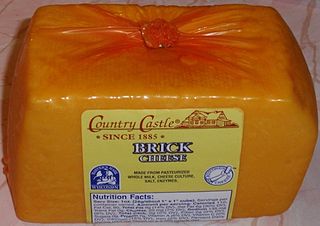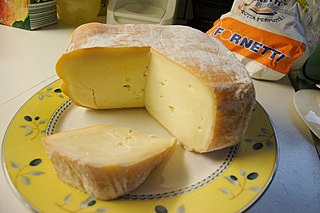
Livarot is a French cheese of the Normandy region, originating in the commune of Livarot, and protected by an Appellation d'Origine Contrôlée (AOC) since 1975.

Blue cheese is semi-soft cheese with a sharp, salty flavor. It is made with cultures of the edible mold Penicillium, giving it spots or veins throughout the cheese in shades of blue or green. It carries a distinct smell, either from the mold or from various specially cultivated bacteria such as Brevibacterium linens, which also causes foot odor and other human body odors.

Brick cheese is a cheese from Wisconsin, U.S., made in brick-shaped form. The color ranges from pale yellow to white, and the cheese has a sweet and mild flavor when young, and matures into a strong, ripe cheese with age. It is a medium-soft cheese.

Ectoine is a natural compound found in several species of bacteria. It is a compatible solute which serves as a protective substance by acting as an osmolyte and thus helps organisms survive extreme osmotic stress. Ectoine is found in high concentrations in halophilic microorganisms and confers resistance towards salt and temperature stress. Ectoine was first identified in the microorganism Ectothiorhodospira halochloris, but has since been found in a wide range of Gram-negative and Gram-positive bacteria. Other species of bacteria in which ectoine was found include:
Brevibacterium is a genus of bacteria of the order Micrococcales. They are Gram-positive soil organisms.
Brevibacterium iodinum is a Gram-positive soil bacterium. It can often be found among the normal cutaneous flora of healthy people, particularly in humid environments, and is only very rarely involved in opportunistic infections. It is also suspected to be a cause of foot odor.

Brevibacterium linens is a gram-positive, rod-shaped bacterium. It is the type species of the family Brevibacteriaceae.
In enzymology, an adenosylmethionine-8-amino-7-oxononanoate transaminase is an enzyme that catalyzes the chemical reaction

There are many different types of cheese. Cheeses can be grouped or classified according to criteria such as length of fermentation, texture, methods of production, fat content, animal milk, and country or region of origin. The method most commonly and traditionally used is based on moisture content, which is then further narrowed down by fat content and curing or ripening methods. The criteria may either be used singly or in combination, with no single method being universally used.
Antarctica is one of the most physically and chemically extreme terrestrial environments to be inhabited by lifeforms. The largest plants are mosses, and the largest animals that do not leave the continent are a few species of insects.
Washed-rind or smear-ripened cheeses are cheeses which are periodically treated with brine or mold-bearing agents. This encourages the growth of certain bacteria on their surface which give them distinctive flavors. Washed-rind cheeses can be hard or soft. The softer ones are sometimes distinguished as "smear-ripened". Conversely, the term "washed rind" is sometimes reserved only for the hard ones.

Năsal is a traditional Romanian cheese bearing the same name as the village where it is produced in the Țaga commune, Cluj County. It is a smear-ripened cheese made from cow's milk. Năsal is produced by Napolact, in a natural cave, traditionally used in the cheese-making process from the Middle Ages. Its characteristics and flavour are imparted by the unique microbiological conditions in which it is manufactured. The rock of the cave and the Brevibacterium linens bacteria which developed in it, the constant temperature and humidity, act on the cheeses produced here.

3-Methylcatechol is a chemical compound, a methylbenzenediol.

Limburger is a cheese that originated in the Herve area of the historical Duchy of Limburg, which had its capital in Limbourg-sur-Vesdre, now in the French-speaking Belgian province of Liège. The cheese is especially known for its strong smell caused by the bacterium Brevibacterium linens.
Arthrobacter protophormiae is a bacterium belonging to the genus Arthrobacter. Formerly it was known as Brevibacterium protophormiae. It contains a glycolipid 3-[O-α-D-mannopyranosyl-(1→3)-O-α-D-mannopyranosyl]-sn-1,2-diglyceride (DMDG). It has peptidoglycan type A4α with a bridge of (Lys–Ala–L-Glu). It has unsaturated menaquinones, dominated by MK-8. It does not contain the lipid phosphatidylinositol.
Pseudoclavibacter is a Gram-positive non-spore-forming, strictly aerobic and non-motile genus from the family Microbacteriaceae. Pseudoclavibacter bacteria can cause endocarditis in rare cases.
Pseudoclavibacter helvolus is a bacterium from the genus Pseudoclavibacter which has been first isolated from butter.
Exiguobacterium acetylicum is a bacterium from the genus of Exiguobacterium.
Brevibacterium limosum is a bacterium from the genus of Brevibacterium which has been isolated from ocean sediments.
Brevibacterium hankyongi is a Gram-positive, rod-shaped, strictly aerobic and non-motil bacterium from the genus of Brevibacterium which has been isolated from compost.








